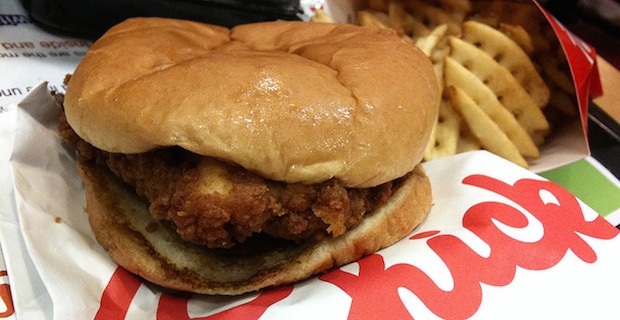
Chick-fil-A, Inc. recently announced its commitment to serving only chicken raised without antibiotics within five years. The company is partnering with all of its poultry suppliers, including national and regional suppliers, to “build a supply chain based on chickens raised with no antibiotics,” as stated on its website. Chick-fil-A, which has almost 1,800 restaurants in 39 states and Washington, D.C., is asking its suppliers to work with the U.S. Department of Agriculture to verify that antibiotics are not used “at any point.”
Read more about antibiotic use in chickens
It will take five years to phase in the new no antibiotics in chickens policy because “a shift this significant will take some time,” said Tim Tassopoulos, executive vice president of operations of Chick-fil-A. Phasing out chickens raised with antibiotics from its supply chain will require “changes along every point of the supply chain – from the hatchery to the processing plant,” he added. The company plans to keep consumers updated on its progress. In 2015, the company will start posting quarterly updates on its website so customers can monitor progress.
“Transparency in our food is important to our customers, and it’s important to us too,” said Dan Cathy, president and chief executive officer of Chick-fil-A. The past couple of years, Chick-fil-A has removed several artificial ingredients from its food, including yellow dye from its chicken soup in 2013, and and tert-Butylhydroquinone (TBHQ), used as a preservative, from peanut oil. In 2008, the fast food chain removed trans fat from all of its menu items and condiments. Chick-fil-A is conducting tests on removing high fructose corn syrup from dressings and sauces, and artificial ingredients from buns.
The company committed to phasing in antibiotic free chickens because its consumers demanded it. Consumer research “indicates an interest in how food is made and where it is sourced, with particular interest in the use of antibiotics,” according to the company’s statement. Or as the company states on its website, “So when our customers started asking us about antibiotics in chicken, we began exploring our options.” Consumers really do want antibiotic-free meat. A Forbes survey in 2012 found that 86 percent of consumers think meat raised without antibiotics should be available in supermarkets, and 72 percent are very concerned about the link between the widespread use of antibiotics and antimicrobial resistance.
Read more about the link between antibiotics, farm animals and superbugs
Antibiotic-resistant infection is a problem in the U.S. where at least two million people become infected with antibiotic-resistant bacteria and at least 23,000 people die as a result every year, according to the Centers for Disease Control. There is a link between the widespread use of antibiotics among livestock and poultry, particularly in animals housed in confined animal feeding operations (CAFOs). The Environmental Protection Agency estimates that there are about 11,000 CAFOs in the U.S. with 30,000 to 125,000 chickens each. Chicken houses can contain 50,000 chickens, and to prevent disease, chickens are given antibiotics. Agricultural use accounts for about 70 percent of all antibiotics use in the U.S., the Union of Concerned Scientists (UCS) estimates.
Photo: DerekThomasLA

